How to Convert PNG to WebP
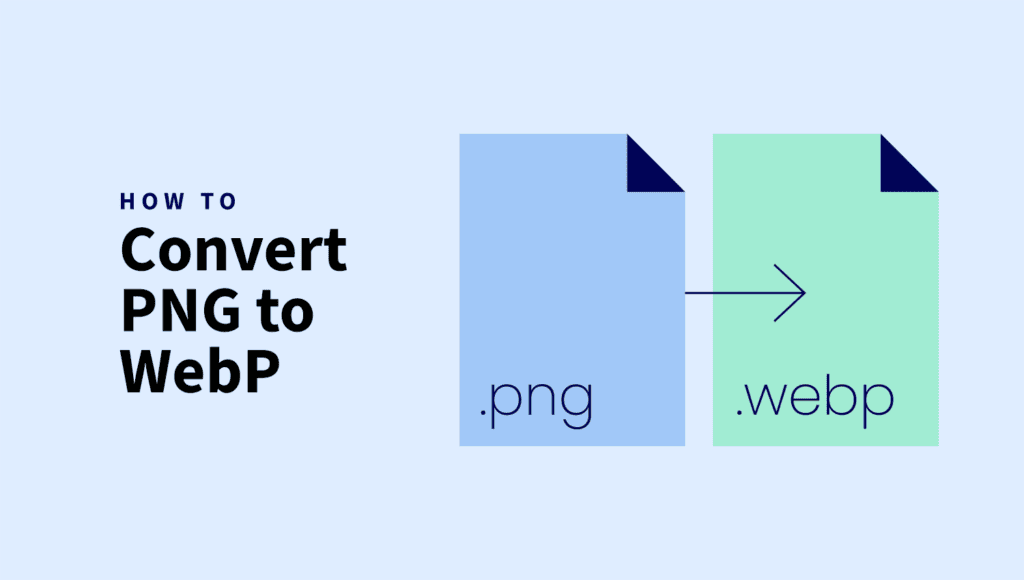
Converting your images to WebP format can unlock many perks, as WebP files are around 23% smaller than comparable PNG image files. This size reduction can significantly boost your website’s performance.
Using WebP thumbnails, YouTube significantly boosted page loading speed, reducing load time by 10%.
Yet, moving from PNG to WebP has its challenges. Since WebP is a newer format, many image editing tools don’t support it, making conversion efficiency difficult.
But don’t worry—we’re here to walk you through the six simplest ways to effortlessly convert PNG to WebP.
Ready to boost your website’s performance? Let’s get started!
Why Should You Convert PNG to WebP?
WebP is the modern image format and Google’s recommended image format.
PNG supports only lossless compression, which makes its file size larger. On the other hand, WebP provides superior lossy and lossless compression. Thus, the WebP file size is smaller than PNG.
WebP lossless images are 26% smaller than PNGs. This reduction helps to reduce web page size significantly. Therefore, improves web page loading speed, which boosts user experience and ranking on the SERP.
WebP images can reduce bandwidth use significantly for websites that use many images. It also makes web browsing smoother for devices with a slower internet connection.
PNG doesn’t support natively. On the other hand, WebP supports animation.
WebP is better than PNG in many ways, providing more benefits.
1. Convert PNG to WebP Free Online
Converting your PNG images to WebP is a breeze with the Shortpixel Image Compressor and WebP Converter tool. It’s a free PNG to WebP converter.
It converts PNG to WebP while also compressing the WebP image. As a result, your PNG images become smaller WebP images.
Let’s see how you can do that,
Step 1: Go to the ShortPixel online compressor and select your desired compression level. You can choose between lossy, glossy, and lossless compression.
Choose lossless to preserve image quality. In contrast, lossy compression rate significantly reduces the size of image files.
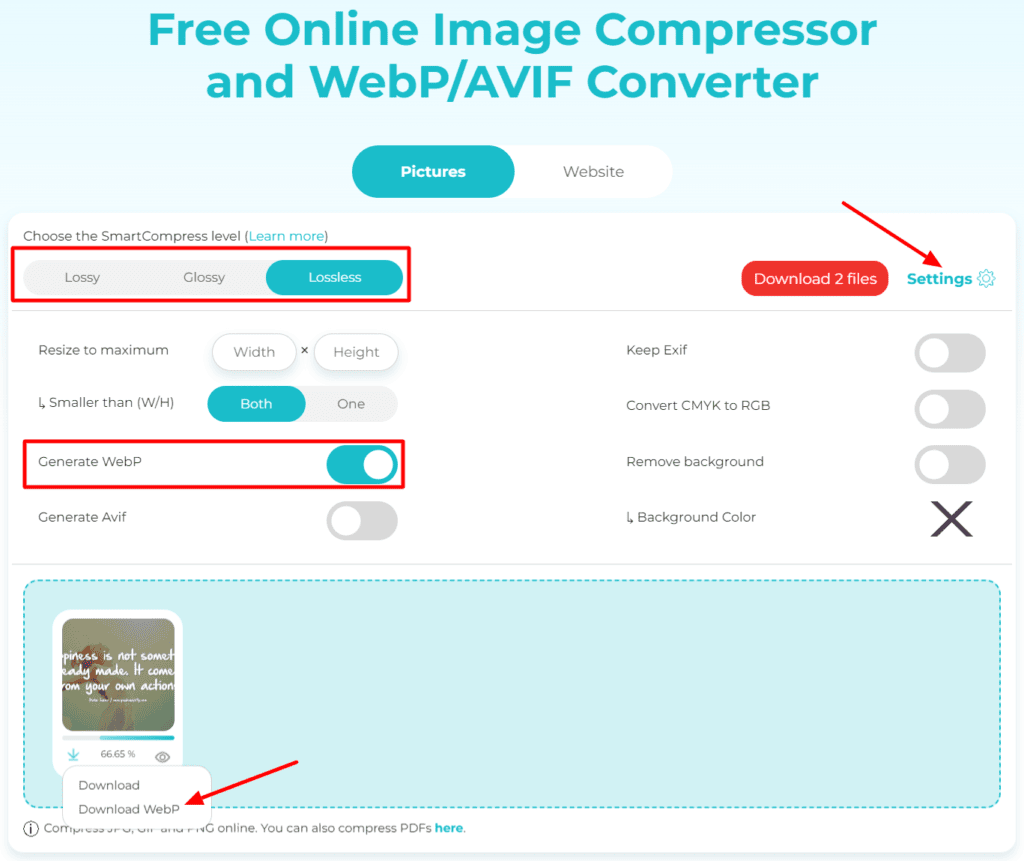
Step 2: Go to Settings and turn on Generate WebP. You can also remove the converted WebP image’s background color.
Step 3: Upload the PNG image to ShortPixel for conversion to WebP. It will be available for download as a compressed WebP image. You can also view the compression percentage.
ShortPixel’s compressor and image converter allow you to process 50 images at once. However, the maximum file size is 10MB, unless you’re logged in. You can sign up for free.
ShortPixel Conversion Tool Features
ShortPixel’s online compressor and batch conversion tool offers a range of features that cater to different needs and workflows, including:
✅ SmartCompress
ShortPixel features advanced in-house built smart compression algorithms that allow you to adjust the compression level to suit your needs.
Whether you prefer lossy compression for smaller file sizes, glossy compression for a balance between quality and size, or lossless compression for preserving image quality, our intelligent algorithm ensure your images maintain their visual integrity.
✅ Resize to maximum dimensions
Specify a maximum width and height for your images, perfect for controlling file size and ensuring your converted images fit within the desired dimensions.
✅ Keep EXIF data
Preserve metadata when compressing images, essential for photo editing workflows where image information is important.
✅ CMYK to RGB conversion
Automatically convert CMYK to RGB, ensuring that images are web-ready and compatible with most digital platforms, increasing the file format versatility.
✅ Generate WebP and AVIF
Quickly convert PNG to WebP or AVIF for modern browsers, ensuring image formats versatility.
This supports the latest next-gen formats for faster loading times.
✅ Remove backgrounds
Automate background removal with ease, and even customize the background color of images.
This is especially useful for image enhancement and photo editing tasks.
✅ Compress multiple formats
Compress various image formats, including JPG, GIF, PNG, and even PDFs!
✅ Drag and drop functionality
Use the drag and drop feature for ease of use, perfect for handling multiple images at once.
✅ Intuitive interface
User-friendly design that makes PNG to WebP generation straightforward and hassle-free.
With drag-and-drop functionality, clearly labeled options, and step-by-step guidance, users can efficiently optimize their images without the need for extensive technical knowledge.
✅ API access
Developers can integrate ShortPixel’s API to automate image compression within their own systems. Conversion APIs enhance automatic optimization processes, useful for web developers focused on performance optimization.
2. Batch Convert PNG to WebP with WordPress Plugin
The ShortPixel Image Optimizer lets you quickly convert all your PNG images to WebP in WordPress. To batch convert PNG format into WebP, follow these simple steps:
Step 1: After installing the ShortPixel plugin, enable the WebP converter. Then go to:
Settings > ShortPixel > Advanced > Create WebP
Selecting the Create WebP option allows the plugin to generate WebP images. Allow this for both new and existing images in your Media Library. The plugin will take care of the rest.
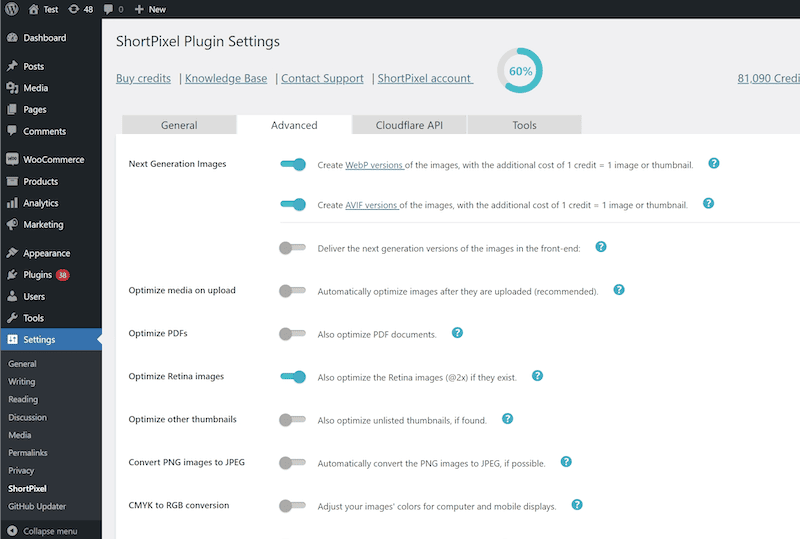
Step 2: Navigate to Media > Bulk ShortPixel. Turn on the “Optimize” toggle for “Media Library” and select the option to create WebP files. To begin the optimization process, click on the “Start Optimizing button.
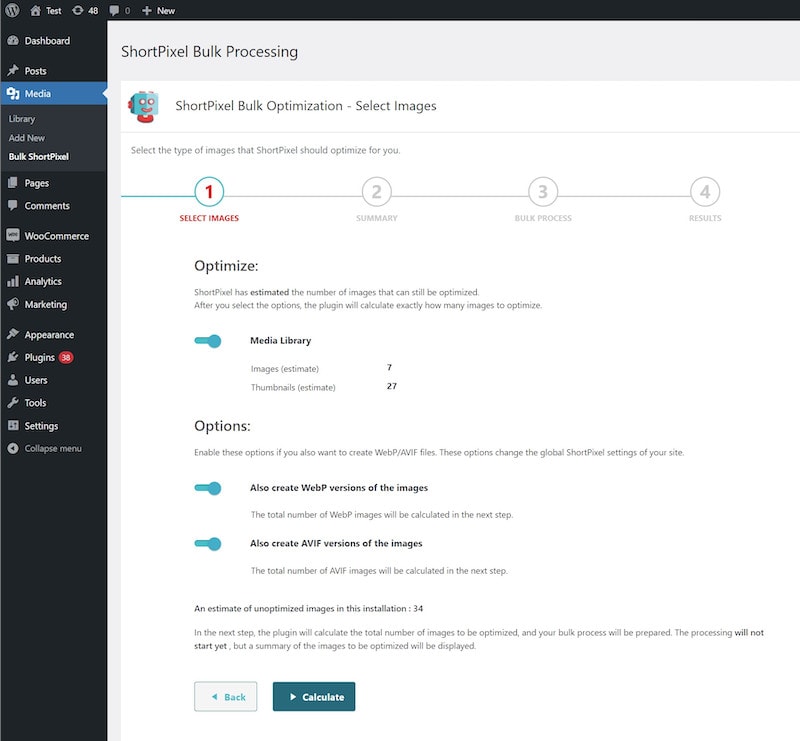
Step 3: ShortPixel offers two options for serving WebP images to your users:
- Use the <PICTURE> tag syntax
- (Via .htaccess) without altering the page code
Select the method that best suits your site’s configuration. It’s best to use .htaccess, but it might not work with all CDNs or NGINX.
Step 4: Check the WebP format of the served images using your browser’s developer tools. You can look at the network tab to see what MIME type the image uses.
3. Convert PNG to WebP Using Adobe Photoshop
Adobe Photoshop is the most widely used photo editing program. It allows you to convert images to a variety of formats while also editing them.
Converting your PNG images to WebP format using Photoshop is a straightforward process. Let’s walk through it together,
Step 1: If you have an Adobe Photoshop version higher than 23.2, install a WebP support add-on to support WebP images. In this case, use this guide.
Step 2: Open Photoshop and load the PNG image you want to convert to WebP. To do so, select File > Open.
Step 3: After you’ve edited the PNG image, select File > Save As.
Use WebP in the “Save as type” format to replace the original PNG image.
If you want to keep your base PNG image, mark it As a Copy; otherwise, the WebP image will replace your orignial PNG image.
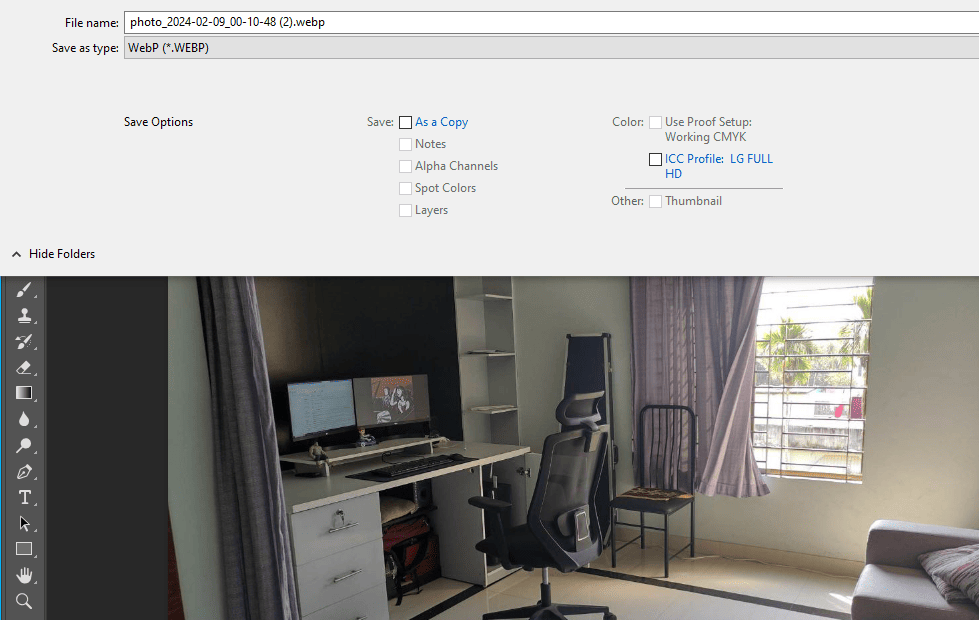
Step 4: When you click “Save a Copy”, a WebP settings dialogue box appears, giving you complete control over configuring WebP settings based on your preferences.
You can also choose between “Lossy and Lossless” compression levels for the image, as well as include or exclude XMP or EXIF metadata.
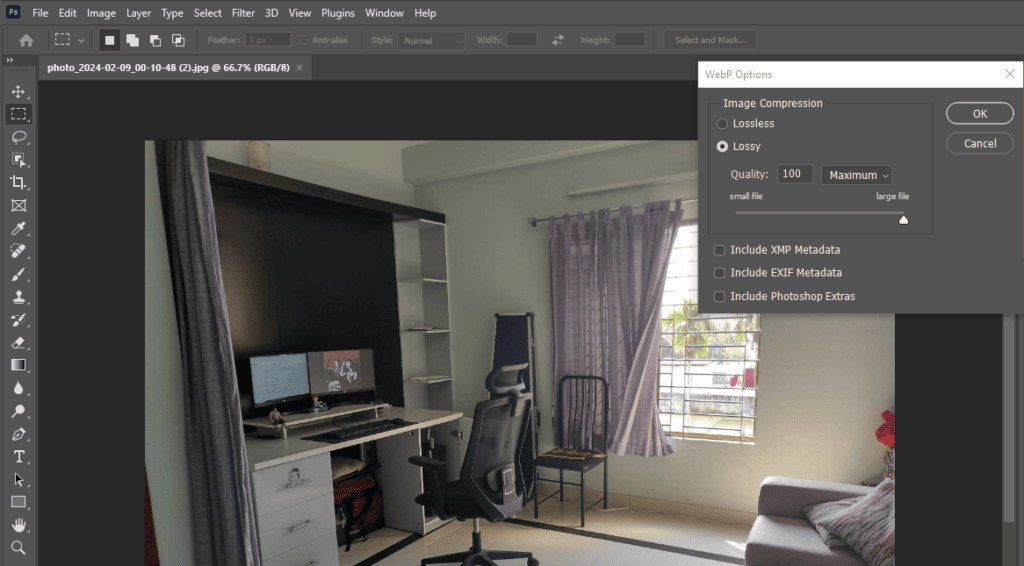
When finished, click “OK” to save the WebP image.
4. Convert PNG Images to WebP on Mac
WebP Converter is a top choice for converting PNG to WebP on Mac. It lets you quickly and efficiently convert PNG to WebP.
Let’s convert PNG to WebP on Mac using WebP Converter:
Step 1: Download and install WebP Converter on your Mac. Then, start the WebP Converter on your Mac.
Step 2: To convert your PNG image to WebP, drag and drop it into the WebP converter. Choose “JPG/PNG to WebP” from the list of convert options.
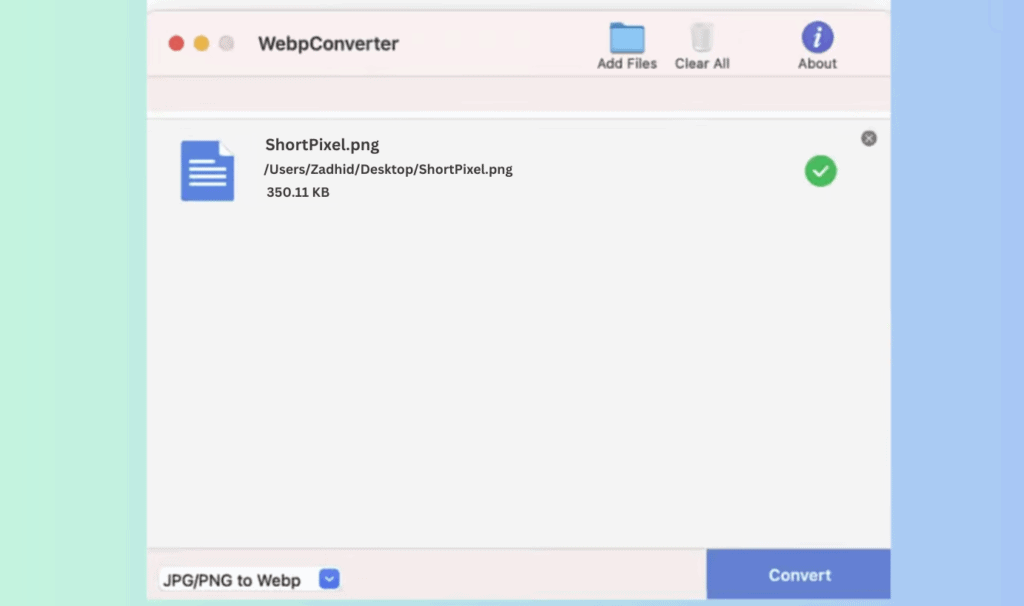
You can adjust the color profile, height, and width, as well as the compression type, to improve the quality of the converted WebP image.
Step 3: Finally, click the “Convert” button in the bottom right corner. Your PNG images will be converted to WebP.
5. Convert PNG to WebP on Linux
Converting PNG to WebP on Linux is easy, thanks to Google’s cwebp tool. Using this tool, you can convert PNG to WebP in a few steps:
Step 1: Install cwebp tools on your Linux system
First, ensure the cwebp tool is installed on your Linux system.
If the cwebp tool is missing from your Linux system, use the package manager to install it. For the Debian system, use the following command:
sudo apt-get install webpStep 2: Convert PNG to WebP on Linux
After installing the cwebp utility on your Linux system, open the PNG image folder and open the terminal. Now, you can use the cwebp command to convert PNG to WebP.
Here is the command for converting PNG to WebP:
cwebp input.png -o output.webpReplace input.png with the name of your PNG file and output .webp with the desired name for the WebP file. For example:
cwebp myimage.png -o myimage.webpOptimize WebP Image Quality in Linux.
You can also adjust the converted WebP quality. For example:
cwebp -q 80 input.png -o output.webpConvert PNG to WebP in Bulk on Linux
If you have multiple PNG files to convert, you can use this command:
for file in *.png; do
cwebp "$file" -o "${file%.png}.webp"
doneThis converts multiple PNG files in your current directory to WebP files.
6. Convert PNG to WebP Using a Google Chrome Extension
You can use the Google Chrome extension “Convert WebP to PNG” to convert PNG to WebP. Here’s a brief overview:
Step 1: Install the extension from the Chrome Web Store.
Step 2: To upload your PNG files, click the extension icon or drag and drop them.
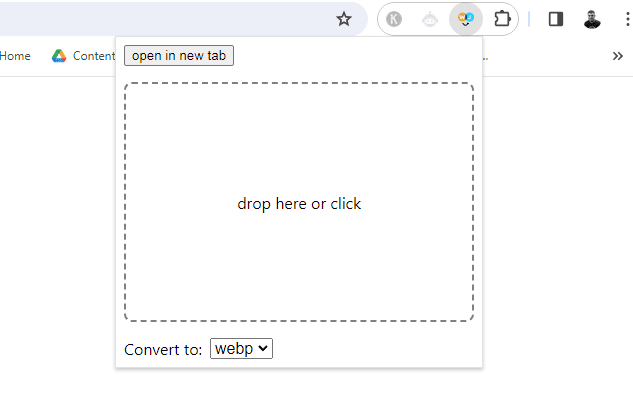
Step 3: Choose a folder and an image name to save your converted WebP image.
Step 4: You can also convert an image in your browser to WebP without downloading it. To convert an image to WebP, right-click it and choose “Save image as WebP.”
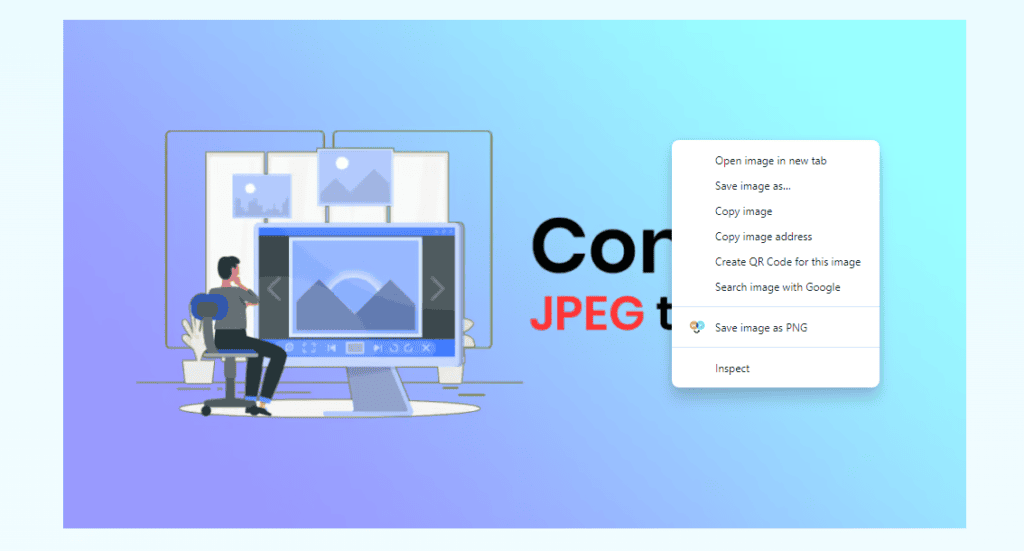
Summary
Switching from PNG to WebP format brings a lot of advantages. Your images will take up less space and help your website run smoother, all without losing the quality of your pictures.
Finding the right way to convert PNG to WebP can make a big difference. This means your website can look great and work quickly, making everyone who visits happy.
The internet’s trends are constantly shifting. Thus, it’s wise to use WebP now. It’s a step forward in making sure your website stands out online.
Convert and Optimize Images for Free!
Enhance your image files effortlessly with ShortPixel, an all-in-one online app that optimizes, resizes, and seamlessly converts PNG to WebP or AVIF formats.
FAQs
What is WebP?
WebP is a modern raster graphics file format developed by Google, designed to replace JPEG, PNG, and GIF formats. It supports both lossy and lossless compression, as well as features like animation and alpha transparency. WebP enables the creation of smaller, high-quality images that load faster on the web, making it a valuable tool for webmasters and developers aiming to improve website performance and user experience.
What are the pros and cons of using WebP images?
The pros of using WebP images are that they offer smaller file sizes without sacrificing much quality, which leads to faster load times and less bandwidth usage. They also support transparency, like PNGs. On the downside, WebP isn’t fully supported by all browsers, especially older ones, so you may need to include fallback images for those users.
What are the limitations of WebP format?
The main limitations of the WebP format are its incomplete browser support, particularly on older systems, and limited compatibility with some image editors or software. Additionally, while WebP does a great job with compression, some extremely high-quality images might still show a slight loss of detail, especially when compared to formats like PNG for lossless images.
How does PNG compare to WebP?
PNG and WebP both support transparency, but WebP generally provides smaller file sizes, which leads to faster loading times. PNGs are lossless, meaning they maintain perfect quality, making them ideal for images that require high detail or text clarity. WebP, on the other hand, offers both lossy and lossless options but is more efficient in terms of compression. The downside of WebP is its limited support on older browsers, while PNG is universally supported across all platforms.
How do I compress WebP images without losing quality?
To compress WebP images without losing quality, you can use an online tool that supports compression for WebP. These tools allow you to upload your WebP images and reduce their file size without affecting the image quality, helping to maintain sharpness and clarity while optimizing for faster loading times. Just upload your images, let the tool do the work, and download the compressed versions.